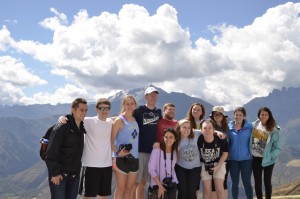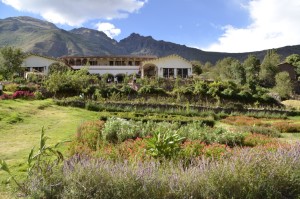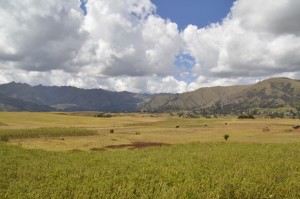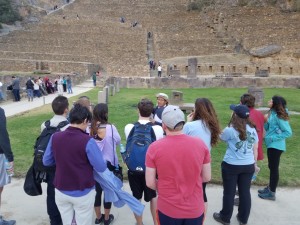12 May 2016

We started to travel in earnest today, they are long, full days of new ideas, smells, sights, landscapes. I always notice the light when I emerge from the airport in Cusco; so clear and intense and white. We have not gotten a good night’s sleep since Saturday night (it’s now Thursday), so we are all tired, there were some excellent bus naps today, mouths agape, heads back, some curled up in the corner of the seat.

Things are changing in Peru, it was so obvious on the landscape. There is a proposed international airport outside of Cusco, and while there are still fields of quinoa and lupine and lima beans and potatoes, a small town of brand new buildings has popped up within a year on a small hill at the end of the proposed site. It’s part of Peru’s sustained economic growth (approximately 7% annual growth for the last ten years or so), but it is sad to imagine that those long vistas will be interrupted. In the high Andes, in between the mountains is the altiplano, a high plateau. It is dotted with adobe brick buildings, no more than two stories at most because that is as high as you can build with adobe. It is early May, so the fields are often golden, ready to harvest, and groups of people dot the landscape as they work together to bring in the potatoes or the quinoa. The sky is a brilliant and clear blue, with sharply defined clouds rolling by, and the mountains are red with iron and gray with copper, with little vegetation to mask the underlying rock. These large peaks have horizontal lines in every nook and cranny, and it is amazing to know that they are small terraces that are farmed. Paths no larger than that needed for a pair of human feet of four llama hooves go up, up, up; they are traveled often during the rainy season so that every space is utilized. Potatoes are only planted in one section of the field every seven years, with the other crops rotated through (including nitrogen fixers to replenish the soil) and a year of rest. So the landscape is this lovely quilt, towered over by reddish peaks, lit by a clear and strong light.

We have visited two traditional homes today, one is a chicheria (an Andean bar, where chicha is made, a beer made from corn), the other a town home in Ollyantaytambo. Perhaps more about the chicheria later, because the small home was just so indicative of a way of life. A family of four inhabited a space of approximately 600 square feet. In one corner is a wood-burning fireplace, with a basket hanging from the ceiling with herbs. The house was stone and Adobe, the beams holding up the roof and the whole inside blackened from years of cooking. A large and colourful blanket held a bundle of grass on the wall for the 30 or so Guinea pigs that scurried primarily in a corner. The Guinea pigs and the 3 or 4 dogs barely notice each other; the Peruvian name for Guinea pigs is “cuy”, because that is the small and high pitched squeak the lovely little things make as they fight over blades of grass. On the wall are just so many things to be curious about: a dried llama fetus and the wing of a condor; small niches with the skulls of the family ancestors with a lit candle next to the decorated cross and a vase of flowers. The family sleeps on layers of blankets placed on the floor or on a simple wooden palette. All of family life takes place in this one room, full of respect and honour for ancestors and Mother Earth.

The other major piece of the day is our first real encounter with the ingenuity and engineering skill of the Inca and pre-Inca cultures. A stand-off between the Spanish and the Inca Tupac occurred here, and the imagery of Tupac on a stolen horse at the top of a massive set of terraces rising to the top of the hill. The stonework is more than remarkable, it is simply indescribable. No mortar, interlocking stones fit perfectly, with no space for a sheet of paper in the joints, at the top of a steep cliff. And the stone quarry was 6km away. And so we are pulling into Agua Calientes (renamed Machu Picchu Pueblo) on the Inca Rail train. Off to Machu Picchu tomorrow, and more wonders.